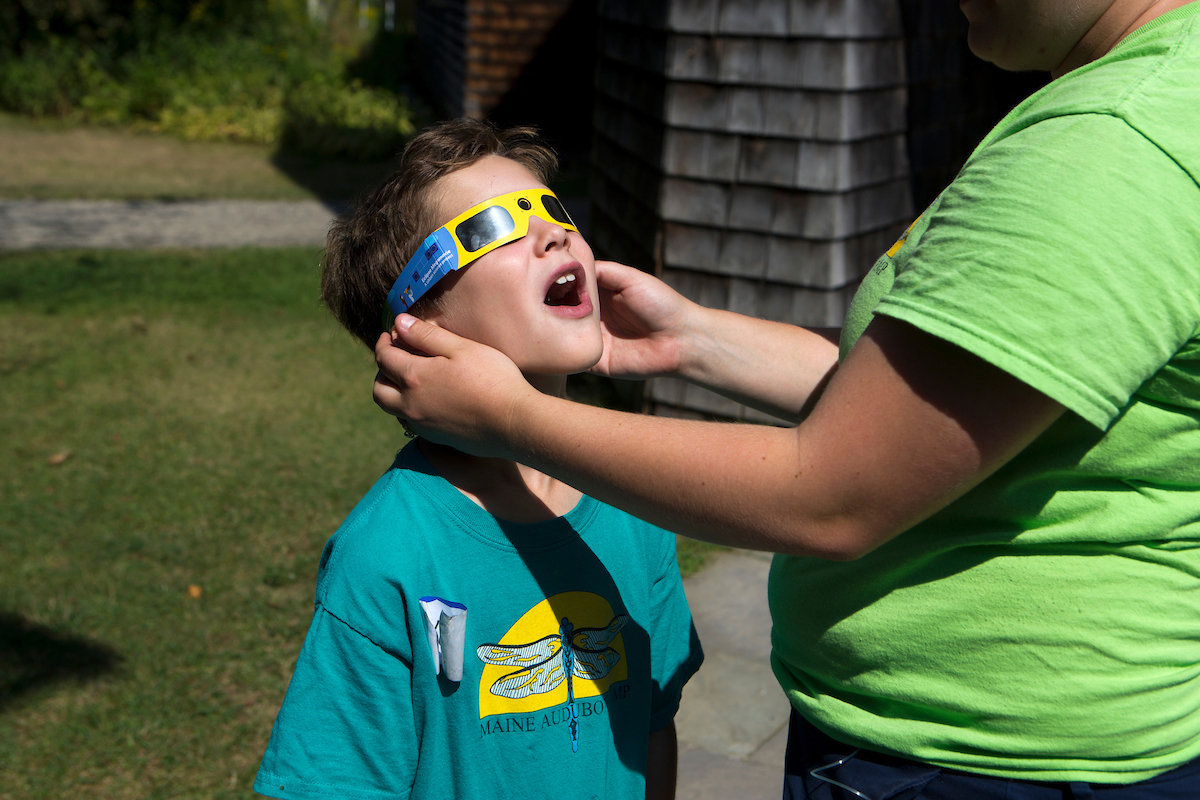
Hopefully you’ve heard by now, but there’s a major astronomical event on the way. On Monday, April 8, 2024, a total solar eclipse will occur over North America, and a big swath of Maine is in the “path of totality.” It’s going to be a big deal no matter where you are in Maine, so we wanted to make sure you’re prepared.
What: A total solar eclipse is where the moon passes between the sun and the earth, blocking the sun’s light from reaching a certain part of the earth for a brief time. The path of the April 8, 2024, eclipse will pass over a narrow band of Mexico, the United States, and Canada. Maine is in the path of the eclipse for the first time since 1963, and April 8 will be the last eclipse to pass over the state until 2079.
Where: The eclipse will be seen all across Maine, but the sun will only be 100% covered in a 110-ish mile wide area known as “the path of totality.” The center of the path of totality will cross west to east over the towns of Jackman and Patten, and extend south to Dover-Foxcroft and north to Caribou.
People in towns outside the path of totality will still experience a dimming of lights and may be able to see the sun’s atmosphere (through special glasses, of course), but the effect will not be as impressive. Consult this map from the National Solar Observatory to see what percentage of the eclipse your area will experience.
How Long Will it Last? The effects of the eclipse will grow and fade as the moon passes over the sun. The eclipse will begin on Maine’s western border at about 2:17 pm, the effects will peak at 3:30 pm, and will end at 4:39 pm. In eastern Maine – in Houlton, for example – the effects will begin at 3:22 pm, peak at 4:33 pm, and end 5:41 pm. Again, consult this map for precise times for your town.
What Can I Do? Many lodgings within the path of totality are already booked for the eclipse, and some have been for years. Plan ahead as soon as you are able to make sure you’re in place before the eclipse begins! Make sure you have eclipse glasses; it is not safe to look up at the sun without them. We’ll have them for sale at our nature stores (while supplies last).
Maine Audubon will host two Eclipse Watch parties, at Fields Pond Audubon Center in Holden and at Gilsland Farm Audubon Center in Falmouth. Feel free to drop in between 3 and 4 pm to join our naturalists, birders, and educators as we observe wildlife at our sanctuaries. At Gilsland Farm, Falmouth peak coverage is 3:31 pm. At Fields Pond, Holden peak coverage is 3:32 pm.
Our Nature Store has eclipse glasses and children’s books about eclipses too. Get the glasses while supplies last! Shop online for pick-up at Gilsland Farm.
and children’s books about eclipses too. Get the glasses while supplies last! Shop online for pick-up at Gilsland Farm.
Please note: Borestone Mountain Audubon Sanctuary is not open in April. We are discouraging visitors there since the weather and trail conditions are unpredictable in early April and it may not be safe. Keep in mind that cell phone service is spotty there, you cannot rely on your GPS, it is a remote area, and icy or muddy terrain is possible.
The Maine Office of Tourism has a special eclipse page with some guidelines, safety notes, and more here.
What Do Wildlife Do in an Eclipse? Maine Audubon staff are eager to observe how local wildlife responds to the eclipse. It’s been more than 60 years since we’ve had the chance!
By all accounts, wildlife respond by acting as if it were suddenly dusk, and move into their nighttime routines. Resident birds may begin singing and then quiet down as they settle in to roost. Spiders have been observed taking down their webs, only to put them back up once the eclipse is over. Conversely, creatures that normally become active at dusk may begin to stir and make noise, like frogs. Nocturnal critters like owls and many mammals may become active during the darkness and emerge from their daytime hideouts.
The April eclipse may be extra-confusing for birds, many of which may be in the early stages of their migration. This blog from BirdCast details examples, seen during previous eclipses, of aerial insectivores like Purple Martins and Chimney Swifts dropping out of the sky and flying at much lower altitudes than normal, looking for areas to roost. In other places, warbler, orioles, and other migrants took the fading sunlight as a signal to begin their nocturnal migrations, and were observed working their way to the tops of trees before flying off.
Unfortunately, April 8 is still the very beginning of bird migration in Maine, and few insect-eating birds aside from some pioneering Eastern Phoebes and Tree Swallows will have arrived. Still, lots of birds will be on the move over and through Maine, including icterids like Red-winged Blackbirds and Common Grackles; American Robins; Song and other sparrows; a variety of waterfowl; Double-crested Cormorants; several egret and heron species; and more. We encourage the Maine Audubon community to watch their local wildlife carefully, and report interesting behavior on eBird or iNaturalist, and send your experiences, anecdotes, and photos to eclipse@maineaudubon.org.
The April 8 total solar eclipse may be a once-in-a-lifetime experience for many Mainers, and it will almost certainly be that for Maine’s wildlife. Let’s experience this incredible moment together.
